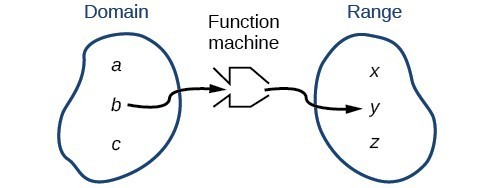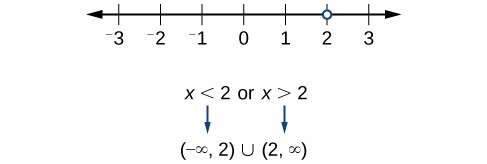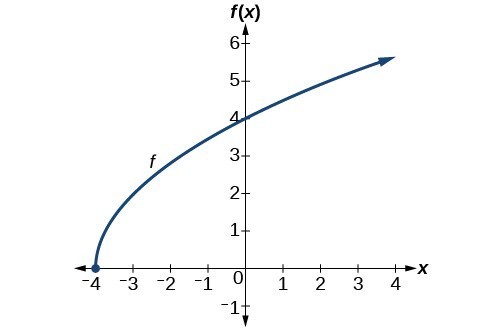Write Domain and Range Given an Equation
Learning Objectives
- Find the domain of a function defined by an equation
- Write Domain and Range Using Standard Notations
 We can visualize the domain as a "holding area" that contains "raw materials" for a "function machine" and the range as another "holding area" for the machine’s products.
We can write the domain and range in interval notation, which uses values within brackets to describe a set of numbers. In interval notation, we use a square bracket [ when the set includes the endpoint and a parenthesis ( to indicate that the endpoint is either not included or the interval is unbounded. For example, if a person has $100 to spend, he or she would need to express the interval that is more than 0 and less than or equal to 100 and write . We will discuss interval notation in greater detail later.
Let’s turn our attention to finding the domain of a function whose equation is provided. Oftentimes, finding the domain of such functions involves remembering three different forms. First, if the function has no denominator or an even root, consider whether the domain could be all real numbers. Second, if there is a denominator in the function’s equation, exclude values in the domain that force the denominator to be zero. Third, if there is an even root, consider excluding values that would make the radicand negative.
Before we begin, let us review the conventions of interval notation:
We can visualize the domain as a "holding area" that contains "raw materials" for a "function machine" and the range as another "holding area" for the machine’s products.
We can write the domain and range in interval notation, which uses values within brackets to describe a set of numbers. In interval notation, we use a square bracket [ when the set includes the endpoint and a parenthesis ( to indicate that the endpoint is either not included or the interval is unbounded. For example, if a person has $100 to spend, he or she would need to express the interval that is more than 0 and less than or equal to 100 and write . We will discuss interval notation in greater detail later.
Let’s turn our attention to finding the domain of a function whose equation is provided. Oftentimes, finding the domain of such functions involves remembering three different forms. First, if the function has no denominator or an even root, consider whether the domain could be all real numbers. Second, if there is a denominator in the function’s equation, exclude values in the domain that force the denominator to be zero. Third, if there is an even root, consider excluding values that would make the radicand negative.
Before we begin, let us review the conventions of interval notation:
- The smallest term from the interval is written first.
- The largest term in the interval is written second, following a comma.
- Parentheses, ( or ), are used to signify that an endpoint is not included, called exclusive.
- Brackets, [ or ], are used to indicate that an endpoint is included, called inclusive.
Example: Finding the Domain of a Function as a Set of Ordered Pairs
Find the domain of the following function: .Answer: First identify the input values. The input value is the first coordinate in an ordered pair. There are no restrictions, as the ordered pairs are simply listed. The domain is the set of the first coordinates of the ordered pairs.
Try It
Find the domain of the function:
Answer:
How To: Given a function written in an equation form that includes a fraction, find the domain.
- Identify the input values.
- Identify any restrictions on the input. If there is a denominator in the function’s formula, set the denominator equal to zero and solve for . If the function’s formula contains an even root, set the radicand greater than or equal to 0, and then solve.
- Write the domain in interval form, making sure to exclude any restricted values from the domain.
Example: Finding the Domain of a Function Involving a Denominator (Rational Function)
Find the domain of the function .Answer: When there is a denominator, we want to include only values of the input that do not force the denominator to be zero. So, we will set the denominator equal to 0 and solve for .
Now, we will exclude 2 from the domain. The answers are all real numbers where or . We can use a symbol known as the union, , to combine the two sets. In interval notation, we write the solution: .
 In interval form, the domain of is .
In interval form, the domain of is .
Try It
Find the domain of the function: .Answer:
Q & A
Can there be functions in which the domain and range do not intersect at all? Yes. For example, the function has the set of all positive real numbers as its domain but the set of all negative real numbers as its range. As a more extreme example, a function’s inputs and outputs can be completely different categories (for example, names of weekdays as inputs and numbers as outputs, as on an attendance chart), in such cases the domain and range have no elements in common.Try it now
When you are defining the domain of a function, it can help to graph it, especially when you have a rational or a function with an even root. First, determine the domain restrictions for the following functions, then graph each one to check whether your domain agrees with the graph.How To: Given the formula for a function, determine the domain and range.
- Exclude from the domain any input values that result in division by zero.
- Exclude from the domain any input values that have nonreal (or undefined) number outputs.
- Use the valid input values to determine the range of the output values.
- Look at the function graph and table values to confirm the actual function behavior.
Example: Finding the Domain and Range Using Toolkit Functions
Find the domain and range of .Answer: There are no restrictions on the domain, as any real number may be cubed and then subtracted from the result. The domain is and the range is also .
Example: Finding the Domain and Range
Find the domain and range of .Answer: We cannot evaluate the function at because division by zero is undefined. The domain is . Because the function is never zero, we exclude 0 from the range. The range is .
Example: Finding the Domain and Range
Find the domain and range of .Answer: We cannot take the square root of a negative number, so the value inside the radical must be nonnegative. The domain of is . We then find the range. We know that , and the function value increases as increases without any upper limit. We conclude that the range of is .
Analysis of the Solution
The graph below represents the function .
Try It
Find the domain and range of .Answer: Domain: Range:
